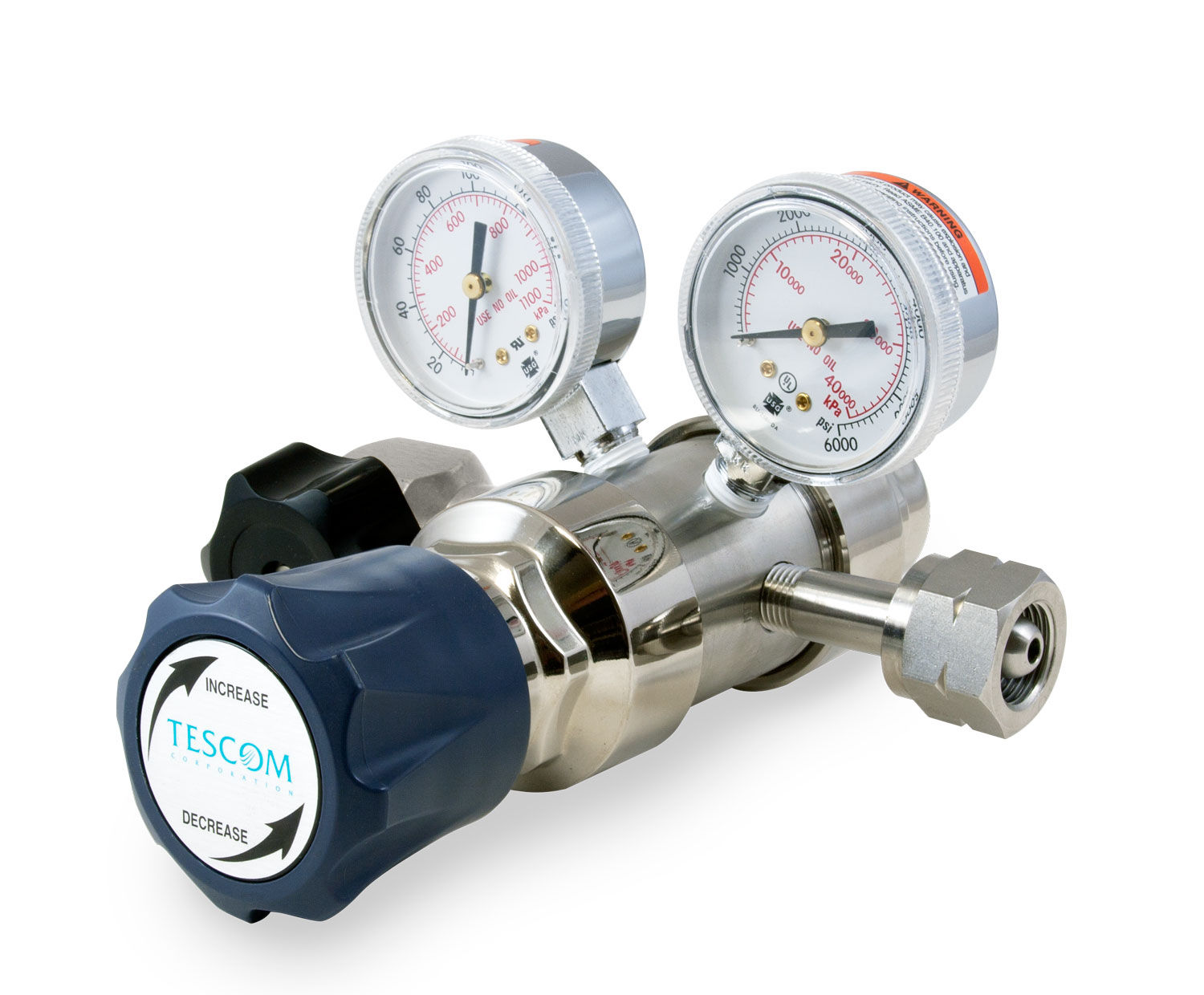
روش انتخاب رگلاتور مناسب
The method of selecting proper regulator
A regulator is a device that can control the pressure to a certain extent in case of a sudden fluctuation of gas flow and moderate it.
Main parts of the regulator
۱.The loading part consists of a weight, spring, gas pressure.
۲.Measuring part or comparatordiaphragm.
۳.Restractor (set orifice)
The regulators are available in spring-loaded and Pilot Regulator-operated models.
In pilot-controlled regulators, the output pressure changes is compared with spring force to the other pilot’s regulator, and the result is applied as gas pressure to the main regulator diaphragm, in other words, the output pressure changes are strengthened and then the prevents the change at valve.
Pilot is a spring-loaded regulator that feeds on the input pressure and provides the output pressure in proportion to the compression ratio of the spring. The pressure is applied as the steering pressure on the main regulator.
The technical characteristic that is important in selecting regulators is their capacity, which is directly related to the input and output pressure and the gas density and its body shape, so that the ratio between the input pressure (P1) and the output pressure (P2) determines the type of output flow from the regulator. And if P2 <P1/ 2 then the flow is absolute critical, and if P2 = P1 / 2, the flow is critical and if P2> P1/2 the flow will be noncritical.
If k is the constant coefficient of the regulator, which depends on the structure of the regulator and the fluid type, the total flow equation in the regulators is:
Q=K(P2(P1-P2))½
The requlator capacity is easily calculated for different pressures based on the above equation and available tables.
A regulator is a device that decreases the high gas pressure in a cylinder or a process line down to a lower pressure.
In order to properly select the correct gas regulator, it is recommended to consider the following points:
Type of gas (corrosive, toxic, neutral and inert as well as oxidizing gas)
The regulator should be fitted with the type of used gas. For example, for oxygen gas, which is a flammable gas and quickly reacts with fat, the regulator must already be degreased and the effect of gas on the metal body of the regulatormust be considered for the corrosive gases.
The place of installing the regulator: Is the regulator installed on the cylinder either in the process line or on the manifold? Each of these cases affects the selection of the regulator.
Input pressure to regulator: It depends on the source pressure of the gas, and it must be proportional to it.
Output pressure: It depends on the consumer’s needs.
The number of pressure gauges and their accuracy: Often, 2 gauges are used on the regulator, one of which shows the input pressure and the other shows the output pressure, and the gauge measurement range should normally be greater than the desired pressure.
The functionalaccuracy of the regulator at the output (single-stage, double-stage or the gas regulatorprecision): This depends on the consumer’s requirements.
Type of the regulator input and output connections: Input connections depend on the gas supply connections (if it is a cylinder, then it will depend on the type of valve) and the output connections depend on the consumer connections.
Regulator be equipped with relief valve controller
The possibility of purging to increase the safety and useful life of the regulator and the entire gas control system by a neutral gas such as nitrogen, especially when the gas used in the regulator is corrosive or toxic.
The operating environment temperature and gas control process
Type of regulator usage (industrial, laboratory and medical)
Regulator material: It Depends on the type of used gas. The following table shows the compatibility of the metals used in the gas regulator:
| Pure gas | Brass | Stainless steel | Aluminum | Plated Brass |
| × | × | × | Acetylene | |
| × | × | × | Helium | |
| × | × | × | × | Argon |
| × | × | Hydrogen | ||
| × | × | × | Ethylene | |
| × | × | × | Ethane | |
| × | × | × | × | Nitrogen |
| × | × | × | Oxygen | |
| × | × | × | Carbon Dioxide | |
| × | × | Carbon Monoxide | ||
| × | × | × | Methane | |
| × | × | × | × | Air |
| × | × | × | Propane | |
| × | × | × | Butane | |
| × | × | Ammonia | ||
| × | Arsine | |||
| × | Chlorine | |||
| × | × | Krypton | ||
| × | Nitric Oxide | |||
| × | Phosphine |
If needed special regulator for helium gas, oxygen gas, nitrogen gas, gaseous hydrogen, and so on,contact Tosse Gas Company
Dinitrogen monoxide
Dinitrogen monoxide, nitrous oxide or laughing gas (N2O) is one of the nitrogen compounds that was first used in dentistry in 1799. Today, it is used in medicine to induce and continue anesthetic. The low amounts of the drug is also used as an analgesia in gynecological surgery and for surgical procedures that do not require complete anesthetic.
Nitrogen oxide application in vehicle enhancement
One of N2O’s applications is to enhance the car. Nitrogen oxide is n’t a fuel that can be burned in the vehicle’s engine and produceenergy. When the gas enters the cylinder, it decomposes into oxygen and nitrogen atoms due to the high heat inside the chamber. In the decomposition, the bond between atoms is broken. The reaction absorbs heat from the cylinder, resulting in the reduction of the combustion chamber temperature. Active oxygen atoms are combined quickly to form an O2 molecule. Now, if we add some extra fuel to the cylinder, we can burn the extra fuel with the produced oxygen gas and generate more power. Note that the burning of excess fuel is possible when the cylinder’s temperature is low and the decomposition of nitrogen oxide provides the required condition. In the process, nitrogen gas does not play any role in the explosion!
Nitrogen oxide (N2O) is a colorless, odorless and non-flammable gas. N2O is not toxic but it’s laughing.
It is stored in pressurized containers called“Bottle Heaters or Bottle Warmers” in the car.
The pressure inside the container should be 850 to 1100 psi in order to keep the gas in liquid phase. The gas is injected into the engine breathing duct (or cylinder) through the pressurized hose. Duringnitrogen oxide injection, the gas goes from the liquid phase to gas phase, since its boiling point is about -84 °C. During thephase change, the temperature of the air mixture decreases and thereforeexplosion process will be carried out better.
Nitrogen oxide is injected into the engine in three ways:
Dried injection: In this case, the N2O gas enters the breathing duct alone and the fueling system is adjusted to bring additional fuel into the engine.
۲. Wet injection: In this injection, the N2O gas and the extra fuel are first mixed together and enter the breathing duct through the nozzle.
Direct injection: In this case, there is an injector for each cylinder, so that N2O gas and additional fuel enter the combustion chamber through each of thenozzles. This case is most commonly used in racing cars.
The injection is carried out with control switches inside the vehicle, which switch connection will actuate the nitrogen-related solenoid. A programmable controller also determines the amount of oxidation nitrogen gas. The controller can be a progressive type that expands the gas volume exponentially or a two-stage type that maximizes gas volume in two steps.
If nitrogen oxide be used properly in the vehicle’s boost system, then it does not create any problem for the engine. It is possible when the system be coordinated with the engine structure and an appropriate N2O pack with protective equipment be applied.
